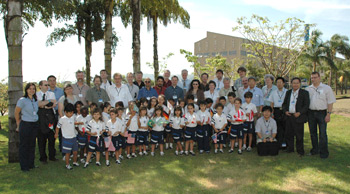 |
 |
|||||||||||||
|
|||||||||||||
|
|||||||||||||
|
Global experts discuss niobium production and progress made on single-crystal and large-grain niobium technology at workshop in Brazil. On the pursuit to design and build a superconducting cavity that will consistently reach the required acceleration gradient of 35 megavolts per metre for the International Linear Collider, a group of 30 scientists from eight industrial companies and nine research laboratories recently came together at the world's largest niobium mine in Araxá, Brazil for the Single-Crystal Niobium Technology Workshop. The workshop educated attendees about the niobium production process and facilitated a dialogue about the development of single-crystal and large-grain niobium for ILC superconducting cavities. Workshop attendees concluded that single-crystal niobium will require more time and resources, but large-grain niobium technology should be seriously pursued for the ILC. "The purpose of the workshop was to bring these parties together and to expand on the positive experiences which have been gained with large grain niobium technology over the last two years," said Ganapati Myneni, a JLab physicist who jointly organised the meeting with CBMM, a niobium vendor. "CBMM sponsored the workshop, and they were a wonderful host for all the participants." Made up of crystals or grains, niobium can be grown in larger or smaller sizes. Single-grain niobium therefore simply consists of one large niobium crystal. In theory the boundaries between the grains in niobium are the energetically preferred areas that might collect contaminants and hinder the performance of the cavity. By eliminating these boundaries, the large-grain and single-crystal cavities, in principle, may perform better by providing fewer places for contaminants to gather and also possibly cut down on expenses by eliminating some of the treatments that are necessary for fine grain cavities. (See ILC NewsLine, 13 July 2006) With cavity R&D studies from JLab, DESY and more recently KEK, producing more and more positive results, the evidence is mounting for the benefits of manufacturing superconducting cavities made from single crystal or large-grain niobium. Even though the stated ILC performance goals for an accelerating gradient of 35 MV/m have been reached in only a few cases, mainly on three single-cell cavities made from single-crystal niobium, this technology may offer significant cost reductions as a result of potentially eliminating such costly processes as electropolishing. In general, lower material costs due to the elimination of the sheet production process for fine grain material are also possible. In this case, the sheets would be simply sliced from an ingot (a mass of niobium that has been heated past its melting point and cast into a long cylinder) by an effective cutting process, which has been developed already by one of the niobium vendors. This single-crystal and large-grain technology might also provide better reproducibility and smaller spread of cavity performance data, one of the major concerns of the presently applied fine grain technology. The major stumbling block for single-crystal niobium technology has always been a question of quantity not quality. The current single-crystal techniques make it difficult to pursue mass quantities at a low cost. Right now the only way to produce a sheet of niobium made from a single-crystal is to slice it from a large-grain ingot (a mass of niobium that has been heated past its melting point and cast into a long cylinder) and then simply cut away the excess material. "This process is not cost-effective because the amount of wasted material is too much," said KEK's Kenji Saito, who attended the workshop. Producing an ingot made entirely from a single-crystal appears to be an ideal way to pursue this type of niobium for the ILC, but the current crystallisation processes make growing single-crystal niobium in this method very expensive. Therefore until it is cost effective to produce single-crystal niobium sheets for the ILC, the large-grain technology will be pursued. A number of R&D studies already support large-grain cavities as an alternative to the baseline, and scientists are planning to build a cryomodule consisting of eight 9-cell large-grain cavities to further demonstrate the technology. "I am quite convinced about the large-grain niobium material," Saito said. Workshop attendees also discussed changes of the present specifications for high purity niobium. Scientists measure the purity of the niobium according to its RRR (residual resistance ratio), which is the ratio between the electrical resistance of the material at room temperature to its electrical resistance at low temperature. The low temperature resistance is mainly determined by impurities in the material. For niobium, these impurities come from hydrogen, carbon, nitrogen, oxygen and a small amount from metallics such as Tantalum (Ta). For superconducting cavities, it is ideal to have impurity contents as low as possible, resulting in a high RRR. Less impurities and a high RRR also means high costs though. Relaxing the specification for this value, presently set at RRR = 300, would reduce the material costs because of a smaller number of melts. At RRR=200, for example, scientists would still be able to achieve high performances from the cavities. A higher Tantalum content, a metal usually found with niobium, would also allow savings in material costs. "We will continue on this topic," Myneni said. "I believe that the community will come together and agree to new specifications that will ultimately cut the costs of niobium." -- Elizabeth Clements |
|||||||||||||
| © International Linear Collider |
